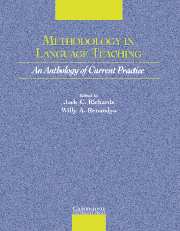Book contents
- Frontmatter
- Contents
- Acknowledgments
- Introduction
- Section I Approaches to Teaching
- Section 2 Lesson Planning and Classroom Management
- Chapter 3 Lesson Planning
- Chapter 4 Classroom Management
- Section 3 Classroom Dynamics
- Section 4 Syllabus Design and Instructional Materials
- Section 5 Task and Project Work
- Section 6 Learning Strategies
- Section 7 Teaching Grammar
- Section 8 Teaching Pronunciation
- Section 9 Teaching Speaking
- Section 10 Teaching Listening
- Section 11 Teaching Vocabulary
- Section 12 Teaching Reading
- Section 13 Teaching Writing
- Section 14 Assessment
- Section 15 Technologies in the Classroom
- Section 16 Professional Development
- Credits
- Author Index
- Subject Index
- References
Chapter 4 - Classroom Management
Published online by Cambridge University Press: 10 November 2010
- Frontmatter
- Contents
- Acknowledgments
- Introduction
- Section I Approaches to Teaching
- Section 2 Lesson Planning and Classroom Management
- Chapter 3 Lesson Planning
- Chapter 4 Classroom Management
- Section 3 Classroom Dynamics
- Section 4 Syllabus Design and Instructional Materials
- Section 5 Task and Project Work
- Section 6 Learning Strategies
- Section 7 Teaching Grammar
- Section 8 Teaching Pronunciation
- Section 9 Teaching Speaking
- Section 10 Teaching Listening
- Section 11 Teaching Vocabulary
- Section 12 Teaching Reading
- Section 13 Teaching Writing
- Section 14 Assessment
- Section 15 Technologies in the Classroom
- Section 16 Professional Development
- Credits
- Author Index
- Subject Index
- References
Summary
TEACHERS' CONCERNS
Language teachers are familiar with the intended outcomes of Communicative Language Teaching, namely, for students to use the new language in speech and in writing for a variety of purposes and in a range of contexts. Teachers also have access to many textbooks setting out activities for doing this. What they often struggle with in their own classes is how to manage classroom learning to achieve these ends. The following comments are grouped into three broad categories: motivation, constraints, and the teacher's role.
Some teachers are concerned about students' motivation:
Students in our school are learning English because they have to. It makes motivation really difficult for the teacher.
Students don't want to use English in class when they can say the same thing faster in their own language. What do other teachers do if one or two students refuse to speak?
For others, constraints are things that teachers believe are stopping them from managing an ideal learning atmosphere:
How can we organize group work when the desks are all fixed to the floor in rows?
Our classes are huge. Whenever I organize tasks, things get messy, such as some students finishing ahead of the others and wasting their time.
How do experienced teachers manage when all the students are at different levels?
We have to achieve examination results. Anything that doesn't lead there is not valued by the school or the parents.
It's hard to access authentic materials for my teaching.
- Type
- Chapter
- Information
- Methodology in Language TeachingAn Anthology of Current Practice, pp. 40 - 48Publisher: Cambridge University PressPrint publication year: 2002
References
- 3
- Cited by



